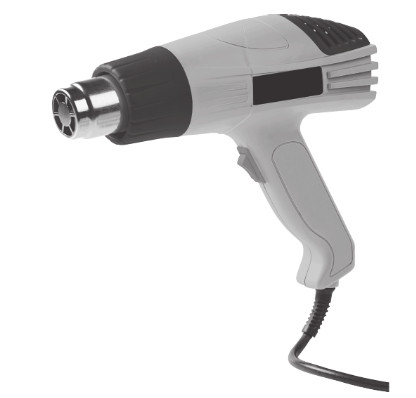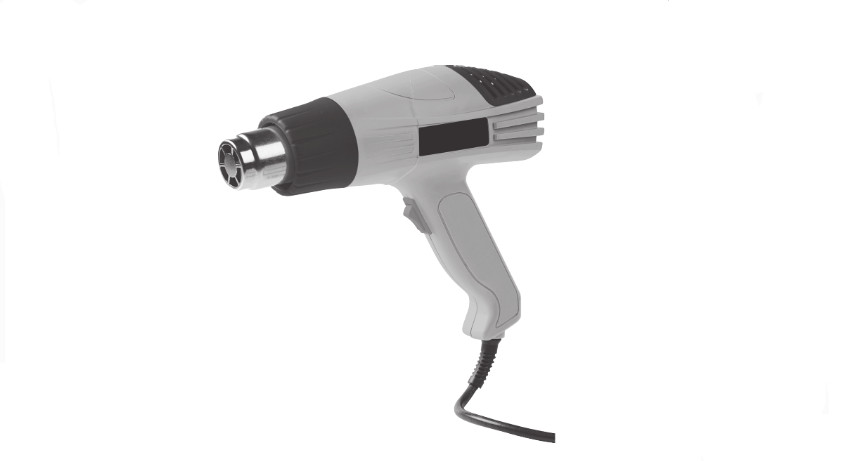

2000W 240VACAdjustable Temperature Heat Gun TH1609User Manual
GENERAL SAFETY INSTRUCTIONS
 Warning! Read all instructions, Failure to follow all instructions listed below may result in electric shock, fire and/or serious injury. The term heat gun in all of the warnings listed below refers to your mains operated (corded) heat gun.
Warning! Read all instructions, Failure to follow all instructions listed below may result in electric shock, fire and/or serious injury. The term heat gun in all of the warnings listed below refers to your mains operated (corded) heat gun.
SAVE THESE INSTRUCTIONS
This appliance is not intended for use by persons (including children) with reduced physical, sensory or mental capabilities, or lack of experience and knowledge, unless they have been given supervision or instruction concerning use of the appliance by a person responsible for their safety. Children should be supervised to ensure that they do not play with the appliance.
- WORK AREAa) Keep work area clean and well lit. Cluttered and dark areas invite accidents.b) Do not operate heat gun in explosive atmospheres, such as in the presence of flammable liquids, gases, or dust. A heat gun can create sparks which may ignite the dust or fumes.c) Keep children and bystanders away while operating a heat gun. Distractions can cause you to lose control.
- ELECTRICAL SAFETYa) Heat gun plugs must match the outlet. Never modify the plug in any way. Do not use any adapter plugs with earthed (grounded) heat gun. Unmodified plugs and matching outlets will reduce risk of electric shock.b) Avoid body contact with earthed or grounded surfaces such as pipes, radiators, ranges, and refrigerators. There is an increased risk of electric shock if your body is earthed or grounded.c) Do not expose heat gun to rain or wet conditions. Water entering a heat gun will increase the risk of electric shock.d) Do not abuse the cord. Never use the cord for carrying, pulling or unplugging the heat gun. Keep cord away from heat, oil, sharp edges or moving parts. Damaged or entangled cords increase the risk of electric shock.e) When operating a heat gun outdoors, use an extension cord suitable for outdoor use. Use of a cord suitable for outdoor use reduces the risk of electric shock.
- PERSONAL SAFETYa) Stay alert, watch what you are doing, and use common sense when operating a heat gun. Do not use a heat gun while you are tired or under the influence of chugs, alcohol or medication. A moment of inattention while operating heat gun may result in serious personal injury.b) Use safety equipment. Always wear eye protection. Safety equipment such as dust mask, non-skid safety shoes, had hat, or hearing protection used for appropriate conditions will reduce personal injuries.c) Avoid accidental starting. Ensure the switch is in the off position before plugging in. Carrying a heat gun with your finger on the switch or plugging in a heat gun that has the switch on invites accidents.d) Do not overreach. Keep proper footing and balance at all times. This enables better control of the heat gun in unexpected situations.e) Dress properly. Do not wear loose clothing or jewelry. Keep your hair, clothing, gloves, loose clothes, or annything that can burn and cause fire.f) If devices are provided for the connection of dust extraction and collection facilities, ensure these are connected and properly used. Use of these devices can reduce dust related hazards.
- POWER TOOL USE AND CAREa) Do not use the heat gun for incorrect applications and use the nozzle attachments as per application.b) Disconnect the plug from the power source before making any adjustments, changing accessories, or storing heat gun. Such preventive safety measures reduce the risk of starting the heat gun accidentally.c) Store idle heat gun, unplugged & out of the reach of children and do not allow persons unfamiliar with the heat gun or these instructions to operate the heat gun. Heat guns are dangerous in the hands of untrained users.d) Keep cutting tools sharp and clean. Properly maintained cutting tools with sharp cutting edges are less likely to bind and are easier to control.
SPECIFICATIONS
Main voltage: 240VAC-50/60HzPower: 2000WTemperature/Air flow: I : 400 C 250IJM, II : 600 C 5000M
TOOL OPERATION
ON-OFF Switch has 3 positionsO: Off position. Ensure the switch is in this position before connecting to the power supplyI: Low Setting. Temperature 400C, at 250 UMII: High Setting. Temperature : 600C, at 5000M
Danger of fire and explosion!Inflammable and poisonous gases may be produced when working with plastics, paints (especially older types of paint), varnishes and similar materials.The ideal temperature should first be ascertained by performing a test. You should therefore start with a low-temperature setting. The working temperature can vary depending on the properties of the workpiece. The distance between the nozzle and workpiece is dependent on the material to be processed.
- Removing paint/dissolving adhesivesSoften the paint using hot air and remove evenly with the scraper.Do not heat the paint for too long since this will burn the paint, making it more difficult to remove. Many adhesives (e.g. stickers) become softer when heated, allowing adhesive bonds to be separated and superfluous adhesive to be removed.
- Removing paint from windowsGlass can break easily. Always use the glass protection nozzle. On profiled surfaces, paint can be removed using a scraper and brushed off using a soft wire brush.
- Shaping plastic tubingFit the reflector nozzle. To avoid kinking the tubing, fill the tubing with sand and seal at both ends. Heat the tubing evenly by moving it from side to side.
- Staining woodFit the reduction nozzle. Hot air staining gives natural wood a rustic effect. Do not hold the nozzle too close to the wood as this will colour the wood unevenly. Carefully sand off any singed wood fibers afterward using fine emery paper.
- Shrink fittingFit the reduction nozzle. Select a heat-shrinkable sleeve with a diameter matching that of the workpiece, e.g.cable lug. Heat the heat-shrinkable sleeve evenly.
- Defrosting water pipesDo not attempt to defrost PVC piping.Fit the reflector nozzle. Always heat the frozen area inwards from the edge to the centre.
Note: Water pipes are often difficult to distinguish from gas pipes. Copper pipes are joined using tin and should therefore not be heated above 200’C.




- Element Take extra care with the heat gun element. Once the element is hot it can become fragile and break if dropped or knocked.
NOZZLES






Distributed by:Electus Distribution Pty. Ltd.320 Victoria Rd, RydalmereNSW 2116 Australiawww.electusdistribution.com.au
Made in China
[xyz-ips snippet=”download-snippet”]

